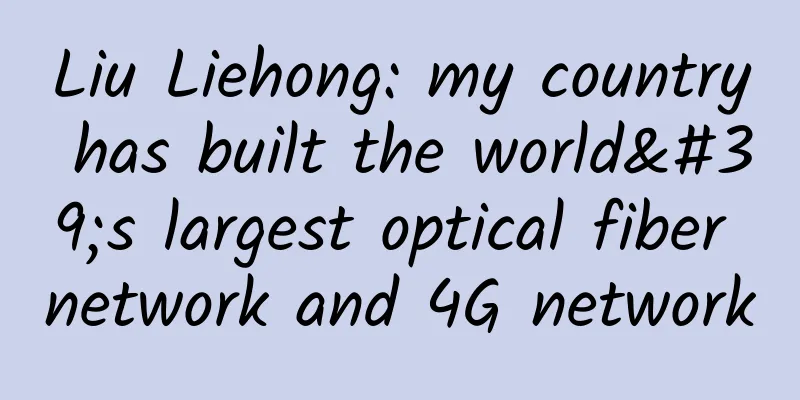How to build the “dual gigabit” expressway in 2021?

|
At the 2021 National Industrial and Information Technology Work Conference held on December 28, 2020, Minister of Industry and Information Technology Xiao Yaqing stated that in 2021, 5G coverage in major cities will be accelerated, joint construction and sharing will be promoted, more than 600,000 new 5G base stations will be built, and the scale of gigabit coverage users will be pushed to exceed 200 million households. Therefore, the key is to upgrade the "dual gigabit" network and cultivate integrated applications in 2021. However, we cannot ignore the four core challenges that the development of "dual gigabit" faces in core chips, operating systems, network architecture and industrial ecology. Of course, "dual gigabit" is not the end. "Dual Gigabit" deployment is accelerating At present, my country's gigabit fixed network is accelerating its formation. According to the latest data from the Ministry of Industry and Information Technology: the number of fixed Internet broadband access users with access speeds of 100Mbps and above reached 432 million, accounting for 89.4% of the total number of users; the number of fixed Internet broadband access users with access speeds of 1000Mbps and above reached 5.88 million, a net increase of 5.01 million households over the end of last year (870,000 households). Especially in the past five years, the proportion of fiber optic users in my country has increased from 34% at that time to 93.6%, and the number of users with gigabit coverage has exceeded 90 million. At the same time, the layout of 5G networks is accelerating. Data shows that in 2020, my country will add approximately 580,000 5G base stations, promote the joint construction and sharing of 330,000 5G base stations, and the goal of 5G coverage in all cities and prefectures set at the beginning of the year has been achieved. In terms of terminals, from January to November 2020, the domestic market shipped 144 million 5G mobile phones, and the number of 5G terminal connections has exceeded 200 million. At the 2021 National Industrial and Information Technology Work Conference held on December 28, 2020, Xiao Yaqing, Minister of the Ministry of Industry and Information Technology, stated that in 2021, the construction and application of 5G networks will be promoted in an orderly manner, 5G coverage in major cities will be accelerated, and co-construction and sharing will be promoted, with more than 600,000 new 5G base stations built. In addition, the Ministry of Industry and Information Technology will also promote network optimization and upgrading, and promote the scale of gigabit coverage users to exceed 200 million households. "Dual Gigabit" network upgrade and integrated application cultivation are key At present, the 10G PON network that supports gigabit access is being rapidly deployed, forming the foundation for the development of gigabit networks. 10G PON has matured across the industry, with the focus on the industry chain (chips, standards and optical modules) of 10G PON. 10G PON has become the common choice of the three major operators for gigabit construction. It is understood that China Telecom's new EPON areas are mainly 10G EPON, and GPON areas are accelerating the upgrade to XG-PON; China Mobile's high-end areas are piloting 10G PON on demand to support market development and ensure gigabit access; China Unicom said it will introduce Combo PON in 2019, and all EPON will be upgraded to 10G EPON in 2021. At the same time, the three major operators are also taking action: China Telecom has established a "dual gigabit" demonstration city in Shanghai; China Unicom is also promoting gigabit broadband speed-up and smart home services in the "1+4+X" smart home business strategy/achieving 80% coverage of provincial capitals/building gigabit cities; China Mobile is building a "three-all, three-intelligent" smart home product system: whole-house smart connection of home networks; whole-house intelligence of home appliances and whole-family smart enjoyment of family life. In addition, Wen Ku, spokesman of the Ministry of Industry and Information Technology and director of the Information and Communications Development Department, once suggested that it is critical to accelerate the construction and upgrading of dual-gigabit networks and cultivate and expand the integrated applications of dual-gigabit. Wen Ku said that to accelerate the construction and upgrading of dual-gigabit networks, we must first take independent networking as the goal, accelerate the construction and coverage of 5G networks in major cities, and gradually extend it to key counties and towns with conditions, continue to carry out research and pilot work on 5G industry virtual private networks, and explore the network architecture and deployment solutions of 5G private networks. At the same time, we will continue to promote the construction and upgrading of gigabit fiber networks, focus on the deep coverage of gigabit homes, industrial parks, schools, hospitals and other scenarios, encourage pilot promotion of fiber-to-the-room and fiber-to-the-desktop services for users with needs, and continuously improve the comprehensive carrying capacity of the network. So, how should we develop and expand the integrated application of dual gigabit? "We should encourage all sectors of society to explore and expand the application space of 5G and gigabit networks in consumer areas such as AR, VR ultra-high-definition video, live e-commerce, telemedicine, and online education, and continue to expand and upgrade new information consumption; promote the innovative application of 5G and gigabit fiber optic networks in production fields such as manufacturing, electricity, transportation, and finance, and form a group of innovative, replicable, and popularizable typical cases, providing solid support for enabling the transformation and upgrading of thousands of industries such as smart manufacturing." Wen Ku said. Dual Gigabit faces four core challenges However, "the development of 'dual gigabit' still faces four core challenges, which are the key to entering the 'dual gigabit' broadband era," said Zhang Jie, executive dean of the School of Electronic Engineering at Beijing University of Posts and Telecommunications. According to reports, these four core challenges are reflected in core chips, operating systems, network architecture and industrial ecology. First, the core chips are a "hard flaw". This is reflected in the heavy reliance on imports and lack of competitiveness in areas such as high-end chips, material manufacturing platforms and instruments. This is due to the gap between technical strength and industrialization level, insufficient original innovation results, and limited leading capacity in international standardization. Therefore, it is necessary to enhance the competitiveness of core materials, devices and chips. Second, the operating system is a "weak point". In the dual-gigabit era, the operating system faces all-round changes in key areas such as networks, terminals, users, and developers. Therefore, it is necessary to deeply cultivate the operating system to support "dual-gigabit" applications. Third, network architecture is an "obstruction". In the context of "dual gigabit" large bandwidth requirements, how to achieve smooth evolution of the current network form to the future architecture, solve the decoupling of the central office and terminal equipment, and realize intelligent control of the network and rapid deployment of end-to-end services are issues that must be considered and resolved. Fourth, the industrial ecology is a "bottleneck". In terms of application innovation, we should deeply explore the needs of vertical fields, encourage wider and deeper collaborative innovation with various industries such as industry, transportation, medical care, energy, and education, and promote the formation of new formats and models as soon as possible; in terms of ecological integration, we should continuously enrich application scenarios, build a broad business ecology, and find integrated dual-gigabit network solutions; in terms of industrial incubation, we should focus on 5G and F5G application innovation to promote dual-gigabit to become a "rigid demand". Of course, "dual gigabit" is not the end. Zhang Jie said that in the future, broadband networks will develop in three directions: first, improving the actual user experience: promoting Wi-Fi network upgrades to improve the actual user network experience; second, focusing on network information security: dual gigabit networks need to pay attention to network content purification and personal privacy protection; third, welcoming the 6G/F6G era: building a "human, machine, object, spirit" network that integrates the earth and the sky, and dual gigabit capabilities need to be further upgraded. |
<<: A few pictures, take down HTTPS
>>: Analysis of domestic 5G development in 2021
Recommend
zgovps: US/Japan/Netherlands/Germany VPS with annual payment starting from $12.9, optional CN2 GIA/AS9929/CMIN2 lines
zgovps is a Chinese hosting company established i...
5G is not only faster, but also safer!
As major operators begin to offer 5G packages, th...
What damage will it cause if the router at home is not turned off for a long time?
The network equipment such as routers has now bee...
From concept to practice, the trend of blockchain is coming
In accordance with the requirements of blockchain...
If 2G and 3G networks are to be shut down, can users still use their mobile phones to surf the Internet and make calls normally?
Recently, the news that China Mobile's 3G bas...
Huawei's Ryan Ding: Working together to create the most successful 5G
On October 14, 2020, at the ICT Leaders Forum, Di...
How is the SSH protocol? Why does a normal connection suddenly report an Identification error?
SSH SSH is mainly a connection protocol. Why do w...
HostDare: 20% off for Japan VPS starting at $18.39/half year, 60% off for Los Angeles VPS starting at $10.4/year
HostDare launched the Japanese VPS at the end of ...
China Economic and Trade Development Park and Huawei signed a strategic cooperation agreement
On September 11, Zhongjing Chengyuan Technology C...
5G keeps refreshing the timetable and the three major operators have finalized the roadmap!
5G has been constantly updating its timetable rec...
8 Software-Based Network Trends for 2019
As networks become increasingly software-based, l...
RAKsmart server flash sale starts from $30/month, 1Gbps unlimited traffic server starts from $99/month
Continuing to share RAKsmart's April promotio...
A brief history of computer networks
The development of computer networks has come a l...
T-Mobile and Sprint to merge
Early morning news on February 11, 2020, accordin...
Have you used "Online Documents"? It allows multiple people to work together and synchronize content in real time. It's so efficient!
Have you ever encountered a situation at work whe...






![[Black Friday] spinservers: $270 off San Jose high-end servers, dual E5-2683 v4, 512G memory, 2*3.83T SSD, 10Gbps bandwidth](/upload/images/67cac499cea2f.webp)


